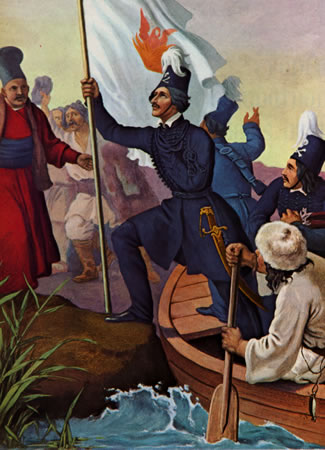|
Alexandros Kantakouzinos
Alexandru Cantacuzino-Deleanu or Alexandros Kantakouzinos ( el, Αλέξανδρος Καντακουζηνός: 1787 in Iași, Moldavia – 1841 in Athens, Greece) was a Phanariote Romanian- Greek magnate and politician. Biography Alexandros Kantakouzinos was born in Iași, in the principality of Moldavia, as a younger son of the boyar Matei Cantacuzino-Deleanu (c. 1750 – c. 1817), justiciar of Moldavia and state councillor of the Russian Empire, and his wife princess Ralou ('Rhalouka', 'Ralitza') Callimachi (1763–1837). Matei Cantacuzino belonged to the Phanariote Greek Cantacuzino family, which had long settled in the Danubian Principalities. Alexandros Kantakouzinos was born during the Russo-Turkish War of 1787–1792, during which Russia occupied parts of the Danubian Principalities for several years. In 1791, Matei Cantacuzino entered Russian service, and the family followed the departing Russian troops to the Russian Empire. Alexandros Kantakouzinos served as a c ... [...More Info...] [...Related Items...] OR: [Wikipedia] [Google] [Baidu] |
Iași
Iași ( , , ; also known by other #Etymology and names, alternative names), also referred to mostly historically as Jassy ( , ), is the second largest city in Romania and the seat of Iași County. Located in the historical region of Western Moldavia, Moldavia, it has traditionally been one of the leading centres of Romanian social, cultural, academic and artistic life. The city was the capital of the Principality of Moldavia from 1564 to 1859, then of the United Principalities from 1859 to 1862, and the capital of Kingdom of Romania, Romania from 1916 to 1918. Known as the Cultural Capital of Romania, Iași is a symbol of Romanian history. Historian Nicolae Iorga stated that "there should be no Romanian who does not know of it". Still referred to as "The Moldavian Capital", Iași is the main economic and business centre of Romania's Moldavian region. In December 2018, Iași was officially declared the Historical Capital of Romania. At the 2011 Romanian census, 2011 census, th ... [...More Info...] [...Related Items...] OR: [Wikipedia] [Google] [Baidu] |
Siege Of Tripolitsa
The siege of Tripolitsa or fall of Tripolitsa ( el, Άλωση της Τριπολιτσάς, Álosi tis Tripolitsás, ), also known as the Tripolitsa massacre ( tr, Tripoliçe katliamı), was an early victory of the revolutionary Greek forces in the summer of 1821 during the Greek War of Independence, which had begun earlier that year, against the Ottoman Empire. Tripolitsa was an important target, because it was the administrative center of the Ottomans in the Peloponnese. Following the capture of the city by the Greek revolutionary forces, a massacre of its Turkish and Jewish population occurred. Background Situated at the center of the Peloponnese, Tripolitsa was the pre-eminent town in southern Ottoman_Greece, Greece, and the capital of the Morea Eyalet (first-level province of the Ottoman Empire) since 1786, which made it an important target for the Greek revolutionaries. Many rich Turks and Jews lived there, together with Ottoman refugees, such as Turks and Albanians fro ... [...More Info...] [...Related Items...] OR: [Wikipedia] [Google] [Baidu] |
Monemvasia
Monemvasia ( el, Μονεμβασιά, Μονεμβασία, or ) is a town and municipality in Laconia, Greece. The town is located on a small island off the east coast of the Peloponnese, surrounded by the Myrtoan Sea. The island is connected to the mainland by a short causeway in length. Its area consists mostly of a large plateau some above sea level, up to wide and long. Founded in the sixth century, and thus one of the oldest continually-inhabited fortified towns in Europe, the town is the site of a once-powerful medieval fortress, and was at one point one of the most important commercial centres in the Eastern Mediterranean. The town's walls and many Byzantine churches remain as testaments to the town's history. Today, the seat of the municipality of Monemvasia is the town of Molaoi. Etymology The town's name derives from two Greek words, (, 'single') and ''emvasis'' (, 'approach'), together meaning "city of the single approach, or entrance". Its Italian form, ''Mal ... [...More Info...] [...Related Items...] OR: [Wikipedia] [Google] [Baidu] |
Peloponnese
The Peloponnese (), Peloponnesus (; el, Πελοπόννησος, Pelopónnēsos,(), or Morea is a peninsula and geographic region in southern Greece. It is connected to the central part of the country by the Isthmus of Corinth land bridge which separates the Gulf of Corinth from the Saronic Gulf. From the late Middle Ages until the 19th century the peninsula was known as the Morea ( grc-x-byzant, Μωρέας), (Morèas) a name still in colloquial use in its demotic form ( el, Μωριάς, links=no), (Moriàs). The peninsula is divided among three administrative regions: most belongs to the Peloponnese region, with smaller parts belonging to the West Greece and Attica regions. Geography The Peloponnese is a peninsula located at the southern tip of the mainland, in area, and constitutes the southernmost part of mainland Greece. It is connected to the mainland by the Isthmus of Corinth, where the Corinth Canal was constructed in 1893. However, it is also connected ... [...More Info...] [...Related Items...] OR: [Wikipedia] [Google] [Baidu] |
Dimitrios Ypsilantis
Demetrios Ypsilantis (alternatively spelled Demetrius Ypsilanti; el, Δημήτριος Υψηλάντης, ; ro, Dumitru Ipsilanti; 1793August 16, 1832) was a Greek army officer who served in both the Hellenic Army and the Imperial Russian Army. Ypsilantis played an important role in the Greek War of Independence, leading several key battles. He was also member of the Filiki Eteria and the younger brother of Alexander Ypsilantis. Early life A member of Phanariote noble Ypsilantis family, he was the second son of Prince Constantine Ypsilantis of Moldavia. He was sent to France where he was educated at a French military school. Union of Moldavia and Wallachia He distinguished himself as a Russian officer in the campaign of 1814. In 1821 he took part in the Wallachian uprising under the leadership of his brother Alexandros, that indirectly benefited the Principalities of Moldavia and Wallachia.East, ''The Union of Moldavia and Wallachia, 1859'', p. 8. The Greek War of Inde ... [...More Info...] [...Related Items...] OR: [Wikipedia] [Google] [Baidu] |
Pruth
The Prut (also spelled in English as Pruth; , uk, Прут) is a long river in Eastern Europe. It is a left tributary of the Danube. In part of its course it forms Romania's border with Moldova and Ukraine. Characteristics The Prut originates on the eastern slope of Mount Hoverla, in the Carpathian Mountains in Ukraine (Ivano-Frankivsk Oblast). At first, the river flows to the north. Near Yaremche it turns to the northeast, and near Kolomyia to the south-east. Having reached the border between Moldova and Romania, it turns even more to the south-east, and then to the south. It eventually joins the Danube near Giurgiulești, east of Galați and west of Reni. Between 1918 and 1939, the river was partly in Poland and partly in Greater Romania (Romanian: ''România Mare''). Prior to World War I, it served as a border between Romania and the Russian Empire. After World War II, the river once again denoted a border, this time between Romania and the Soviet Union. Nowadays, for a le ... [...More Info...] [...Related Items...] OR: [Wikipedia] [Google] [Baidu] |
Filiki Etaireia
Filiki Eteria or Society of Friends ( el, Φιλικὴ Ἑταιρεία ''or'' ) was a secret organization founded in 1814 in Odessa, whose purpose was to overthrow the Ottoman rule of Greece and establish an independent Greek state. (''retrieved from University of California Library'') Society members were mainly young Phanariot Greeks from Constantinople and the Russian Empire, local political and military leaders from the Greek mainland and islands, as well as several Orthodox Christian leaders from other nations that were under Hellenic influence, such as Karađorđe from Serbia, Tudor Vladimirescu from Romania, and Arvanite military commanders. One of its leaders was the prominent Phanariote Prince Alexander Ypsilantis. ''retrieved 9 May. 200Encyclopedia.com' The Society initiated the Greek War of Independence in the spring of 1821. Translations and transliterations The direct translation of the word "Φιλική" is "Friendly" and the direct translation of "Ἑται� ... [...More Info...] [...Related Items...] OR: [Wikipedia] [Google] [Baidu] |
Alexandros Ypsilantis
Alexandros Ypsilantis ( el, Αλέξανδρος Υψηλάντης, Aléxandros Ypsilántis, ; ro, Alexandru Ipsilanti; russian: Александр Константинович Ипсиланти, Aleksandr Konstantinovich Ipsilanti; 12 December 179231 January 1828) was a Greek nationalist politician who was member of a prominent Phanariot Greek family, a prince of the Danubian Principalities, a senior officer of the Imperial Russian cavalry during the Napoleonic Wars, and a leader of the Filiki Etaireia, a secret organization that coordinated the beginning of the Greek War of Independence against the Ottoman Empire. Early life The Ypsilantis family hailed from the Pontic Greek population of Trabzon. He was born on 12 December 1792 in Constantinople, the capital of the Ottoman Empire, as the eldest of five brothers (the others being Demetrios, Nicholas, Georgios and Grigorios). His father Constantine Ypsilantis and grandfather Alexander were active in the Ottoman administrat ... [...More Info...] [...Related Items...] OR: [Wikipedia] [Google] [Baidu] |
Eastern Moldavia
Bessarabia (; Gagauz: ''Besarabiya''; Romanian: ''Basarabia''; Ukrainian: ''Бессара́бія'') is a historical region in Eastern Europe, bounded by the Dniester river on the east and the Prut river on the west. About two thirds of Bessarabia lies within modern-day Moldova, with the Ukrainian Budjak region covering the southern coastal region and part of the Ukrainian Chernivtsi Oblast covering a small area in the north. In the aftermath of the Russo-Turkish War (1806–1812), and the ensuing Peace of Bucharest, the eastern parts of the Principality of Moldavia, an Ottoman vassal, along with some areas formerly under direct Ottoman rule, were ceded to Imperial Russia. The acquisition was among the Empire's last territorial acquisitions in Europe. The newly acquired territories were organised as the Bessarabia Governorate of the Russian Empire, adopting a name previously used for the southern plains between the Dniester and the Danube rivers. Following the Crimean War ... [...More Info...] [...Related Items...] OR: [Wikipedia] [Google] [Baidu] |
Russo-Turkish War (1806–1812)
The Russo-Turkish War (1806–1812) between the Russian Empire and the Ottoman Empire was one of the Russo-Ottoman Wars. Russia prevailed, but both sides wanted peace as they feared Napoleon's moves to the east. Background The war broke out against the background of the Napoleonic Wars. In 1806, Sultan Selim III, encouraged by the Russian defeat at Austerlitz and advised by the French Empire, deposed the pro-Russian Constantine Ypsilantis as Hospodar of the Principality of Wallachia and Alexander Mourousis as Hospodar of Moldavia, both Ottoman vassal states. Simultaneously, the French Empire occupied Dalmatia and threatened to penetrate the Danubian principalities at any time. In order to safeguard the Russian border against a possible French attack, a 40,000-strong Russian contingent advanced into Moldavia and Wallachia. The Sultan reacted by blocking the Dardanelles to Russian ships and declared war on Russia. Early hostilities Initially, Emperor Alexander I was rel ... [...More Info...] [...Related Items...] OR: [Wikipedia] [Google] [Baidu] |
French Invasion Of Russia
The French invasion of Russia, also known as the Russian campaign, the Second Polish War, the Army of Twenty nations, and the Patriotic War of 1812 was launched by Napoleon Bonaparte to force the Russian Empire back into the continental blockade of the United Kingdom. Napoleon's invasion of Russia is one of the best studied military campaigns in history and is listed among the most lethal military operations in world history. It is characterized by the massive toll on human life: in less than six months nearly a million soldiers and civilians died. On 24 June 1812 and the following days, the first wave of the multinational crossed the Niemen into Russia. Through a series of long forced marches, Napoleon pushed his army of almost half a million people rapidly through Western Russia, now Belarus, in an attempt to destroy the separated Russian armies of Barclay de Tolly and Pyotr Bagration who amounted to around 180,000–220,000 at this time. Within six weeks, Napoleon lost ... [...More Info...] [...Related Items...] OR: [Wikipedia] [Google] [Baidu] |
.png)



